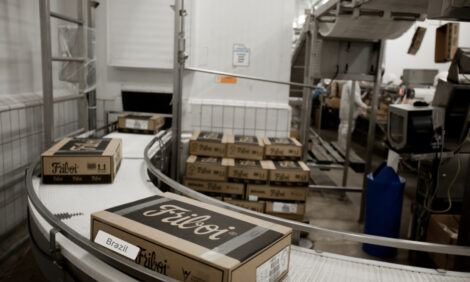



E. coli O157 Vaccine: Added Value or Added Cost
CANADA - A Canadian biopharmaceutical company, recently hosted a two-day conference in Toronto on how farmers can use E. coli vaccinations to add value to beef and dairy products.Guest speakers included Dr. David Biesenthal, a veterinarian in Walkerton, Ontario whose cattle farm was one of those implicated in the town's water contamination with E. coli O157:H7 in 2000. Dr. Biesenthal is one of the first adopters of a vaccination program using the Bioniche E. coli O157:H7 cattle vaccine. "Vaccination of all cattle could help reduce the opportunity for another incident like the one that occurred in Walkerton and would demonstrate due diligence," he said.
Kevin Grier, Senior Market Analyst with the George Morris Centre in Guelph, Ontario presented data from an economic cost-benefit analysis completed for Bioniche related to the vaccine. The analysis concluded that there is a potential $2 saved for every $1 spent on vaccination of the Canadian cattle herd.
* "I believe that vaccine technology probably has the broadest application and is the most widely implementable." |
|
Dr. Guy Loneragan, Associate Professor, Agriculture Sciences and Epidemiologist in the Feedlot Research Group at West Texas A&M University.
|
Dr. John Fairbrother, Director of the Reference Laboratory for Escherichia coli (E. coli) at the University of Montreal discussed a variety of potential intervention strategies to address on-farm contamination with E. coli. He concluded that an optimal strategy is a global approach, using combined intervention strategies to improve food safety. Dr. Fairbrother was named as World Health Organization expert on E. coli in 2006.
Dr. David Smith, Professor and Extension Dairy/Beef Veterinarian in the Department of Veterinary and Biomedical Sciences at the University of Nebraska-Lincoln summarized the results of field studies with the Bioniche vaccine at university feedlots over the last six years. He noted that the Bioniche vaccine fulfils the expectations of an efficacious vaccine.
Another guest speaker was Dr. Guy Loneragan, Associate Professor, Agriculture Sciences and Epidemiologist in the Feedlot Research Group at West Texas A&M University. Dr. Loneragan discussed his analysis of the applied interventions against E. coli O157:H7 in real-world studies, as well as peer-reviewed publications. In response to the question, "How much intervention is enough?", Dr. Loneragan said, "If we knew the pathogen threshold level in meat processing plants - the acceptable level that meat processing and packing facilities can handle with internal interventions - we could easily assess the efficacy required of a pre-harvest intervention. Unfortunately, this threshold is yet to be well-defined. That said, however, the vaccine intervention appears to change summertime shedding patterns into winter-type patterns. Empirical data from human health tells us this change is important. I believe that vaccine technology probably has the broadest application and is the most widely implementable."
Dr. Doug Powell, Associate Professor in the Department of Diagnostic Medicine/Pathobiology at Kansas State University, discussed the need to create a food safety culture, from farm-to-fork, 24/7. He emphasized that risk reduction strategies are key to ensuring food safety. "The Bioniche vaccine is a technology to reduce risk. Any tool you can provide for risk reduction will help."
"We are pleased with the level of interest in our vaccine on the part of veterinarians, researchers and the food industry," said Rick Culbert, President of Bioniche Food Safety. "We are in an awareness building phase, whereby we are introducing various segments of the food industry to both our vaccine and the impact of E. coli O157:H7 on human health."
Bioniche has developed the world's first cattle vaccine that may be used as an on-farm intervention to reduce the amount of E. coli O157:H7 shed by cattle. This will be the first product manufactured in the scaled-up production facility being developed in Belleville, Ontario. The vaccine is unique in that it helps to reduce shedding of an organism that, while potentially lethal to humans, causes no disease in cattle. The Company obtained approval to distribute its vaccine under the Permit to Release Veterinary Biologics regulations by the Canadian Food Inspection Agency (CFIA) in December, 2006. In February of this year, the United States Department of Agriculture (USDA) granted eligibility for conditional licensing of the vaccine.
It remains very clear that there is a pressing need to reduce the amount of E. coli O157:H7 shed into the environment by cattle. Food recalls continue to occur on a regular basis in beef, produce and prepared food. On-farm interventions to reduce the shedding of E. coli O157:H7 by cattle, such as vaccination, may assist in reducing the potential for food and water contamination and the resulting human illnesses and deaths.
Approximately 100,000 cases of human infection with the E. coli O157:H7 organism are reported each year in North America. 2% to 7% of those people develop hemolytic uremic syndrome (HUS), a disease characterized by kidney failure (in recent outbreaks, this percentage has risen to as high as 16%). Five percent of HUS patients die, many of them children and senior citizens, whose kidneys are more sensitive to damage.
Beyond consumption of contaminated food or water, individuals can become infected from E. coli O157:H7 by visiting animal exhibits. Petting zoos, fairs, and agricultural exhibits provide many possible routes of transmission for E. coli. Direct animal contact is the obvious route, but contact with contaminated products (e.g., sawdust, shavings, soiled clothing or shoes) can also lead to human infection.
TheCattleSite News Desk


